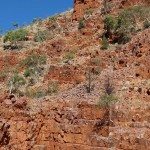One way to reacquaint yourself with natural human rhythms and your own peace of mind is to slow down to a walking pace, through experiences and life in general. ‘El Camino de Santiago’ (St. James’ Way) certainly offers the chance to be with your own thoughts as well as in the company of others who are sharing this extraordinarily rewarding personal challenge. On this kind of ‘slow road’ you can find a new vitality and appreciate the wonders around you, while stepping confidently into an ancient and sacred context.
History of the Camino de Santiago
Tradition says that the Apostle St. James journeyed to the Roman province of Hispania (now known as Spain) in order to evangelise its population. On his return to Jerusalem, he was arrested and martyred. His disciples recovered his body, together with its severed head, and brought it back to Spain in a stone boat to the port of Iria Flavia, in Galicia, burying it a few kilometres farther inland, sometime in the fourth century. The tiny harbour church at Padrón near Corunna preserves the mooring-post to which the boat was said to be tied. From the earliest period of Christianity, legend recalls the memory of the preaching and burial of St. James in this western most region, referred to as the finis terrae or the ends of the earth.
Successive barbarian and Muslim invasions drew a shroud of silence over his tomb. Some two hundred years later the site of the saint’s shrine at Libredon, or Santiago, attracted a growing stream of pilgrims. In 859 the invocation of St. James gave the Christians of Leon a miraculous victory over the Moors and the saint gained the epithet of Matamoros or ‘Moor slayer’, as Leon evolved into a sovereign kingdom.
The Heart Cockle
Around 899 a new cathedral was built over the tomb as a focus for the pilgrimage, with the pilgrim’s scrip and Atlantic cockleshell, as its emblems. The ‘heart cockle’, or Cardium edule, has been a symbol of love throughout the ages and was given to lovers as tokens of sailors’ affections. It is said to restore the energy of the feminine aspect of the soul, healing the scars of the land and traumas of the past.
Pilgrims’ motives for the trek half way across Western Europe were not so plain and hardly simple. Some set out with a fervent belief in the power of saints to intercede for their souls, others for a physical cure, and still others for the sheer rollicking adventure and camaraderie, or for reasons of lust, financial gain or escape. Santiago was ‘as far as one could go’ with the legitimizing endorsement and formal penance of the Church.
European Cultural Mecca
In 1987 the Council of Europe proclaimed Santiago de Compostela the first European Cultural itinerary. Some 1,800 buildings along the French way, both religious and secular, played a fundamental role in encouraging cultural exchanges between the Iberian Peninsula and the rest of Europe during the Middle Ages, and remain a testimony to the power of Christianity among people of all social classes and from all over Europe.
Our Route
We begin our walking from St. Jean de Pied Port, a small, cobbled stone French town in the Lower Navarra, which is the last stop in France for those crossing the Pyrenees Mountains en route to Santiago. Here you pick up your pilgrim’s passport or ‘credential’ and set off across some of the most idyllic scenery in Europe. Walking along an old Roman road, once connecting Astorga to Bordeaux, we arrive in Roncesvalles.
At its height in the fourteenth and fifteenth centuries, the refuge here reputedly served 30,000 meals a year in the major transcontinental business of pilgrimage. Charlemagne’s army, led by his nephew Roland, was defeated here in 778 and later immortalised in the medieval poem ‘The Song of Roland’. We walk on to Burguete, towards Zubiri through the beautiful lower regions of the Pyrenees, crossing beech forests, charming villages and open farmland to Alto de Erro, and onto Olite near Pamplona, on our way to the evocative village of Puenta La Reina (with its Romanesque ‘Queen’s Bridge’) on the banks of the Agra River.
We continue our journey across gentle open countryside, vineyards, and small medieval villages, along a path that still retains its original Roman stones, heading for the beautiful town of Laguardia in the heart of the famous Rioja wine region. We savour the ‘bold reds’ and ‘piquant tapas’ in the main square, ‘la Plaza Mayor’, where the locals live to eat and drink, and merrily watch an unusual clock, the ‘Reloj de Carillon’, and its dancing hands.
We head for Burgos, which boasts a magnificent Gothic cathedral and a local guide named Luis, whose enthusiasm for his work and pride in his heritage pulsates with the very energy of El Cid himself! We move on to explore the Royal Pantheon of San Isidoro in Leon, after relaxing at the ‘Hostal San Marcos’, which rather resembles a Spanish style Buckingham Palace. Approaching our ultimate destination, we leave our longing gaze in small, relatively modest, but touchingly memorable towns like, Villafranca del Bierzo, O Cebreiro, Sarria, Portomarin, Vilarino, and Rua.
Reaching the Cathedral of Santiago de Compostela we are welcomed by its magnificent façade, with its centre-stage presence dominating the ‘Plaza do Obradoiro’; an amazing town square populated by the ghosts and stories of all those who have set foot in one of the most visited regional capitals of the world. Our Parador, the impressive ‘Hostal Reyes Católicos’, is said to be one of the oldest hotels in the world and certainly fulfils the promise of an indulgent rest and many luxurious rewards. Its origins as a Royal Hospital in 1499, sheltering the numerous travellers making their way to Santiago, still invite modern-day feet to take great comfort on its plush red carpets.

